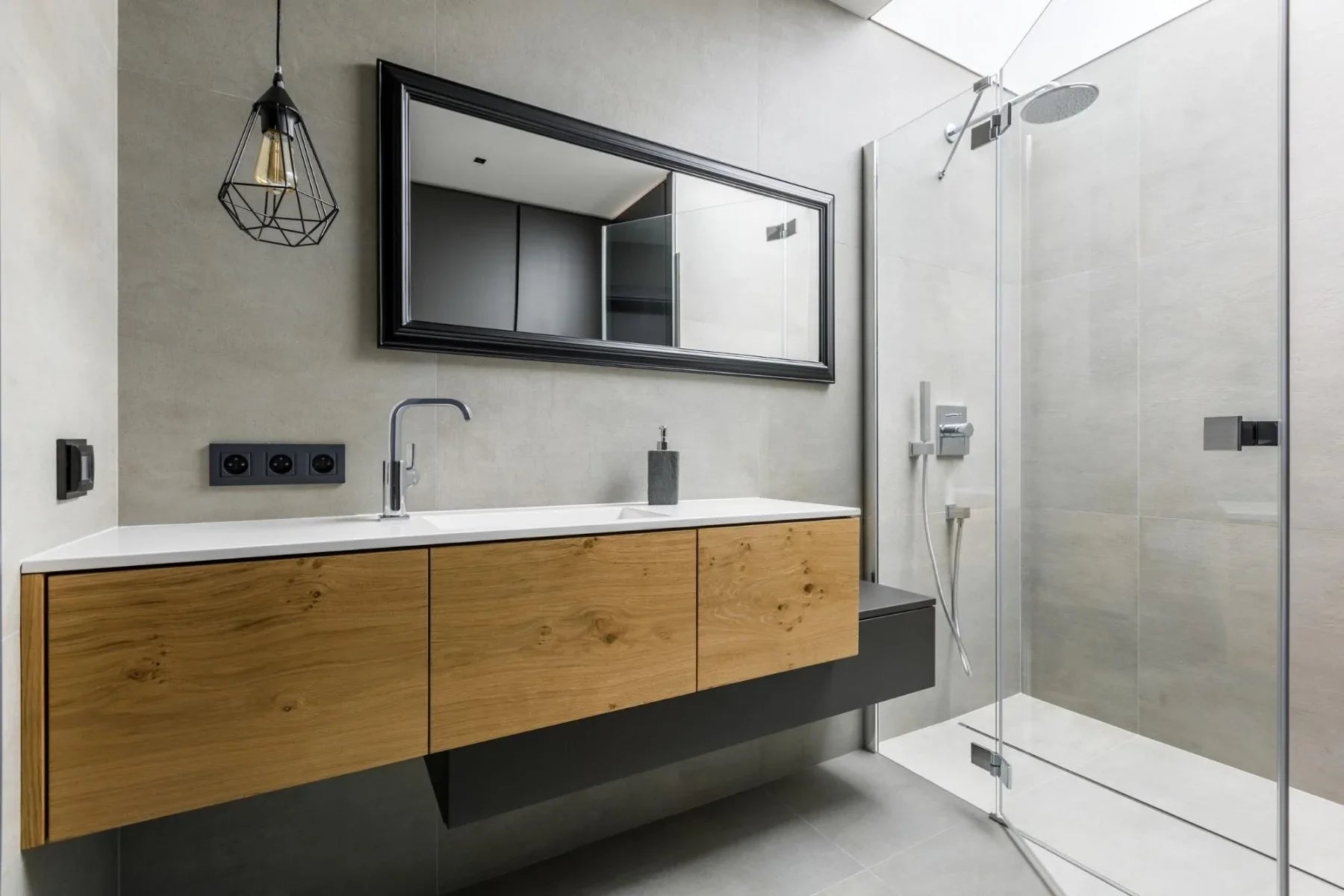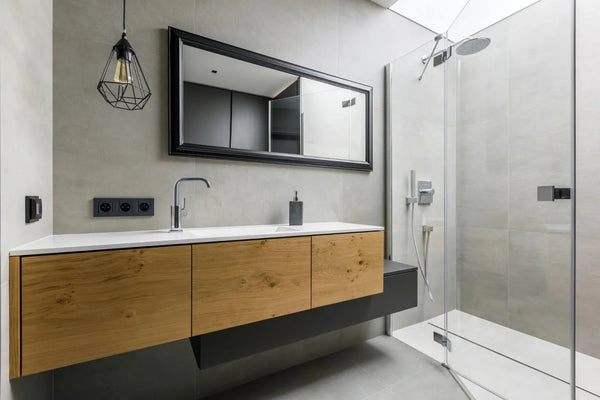Basements, warehouses, schools: these are all buildings in which we normally see concrete. But concrete interiors are rising in both scale and scope throughout the home.
The durable, minimalist nature of concrete makes it a solid foundation for many spaces, but it works especially well in the bathroom. From walls and floors to sinks and showers, here’s how to use concrete in your bathroom.
How to Use Concrete in Interior Design
There are three different types of concrete commonly used across interior design, according to lifestyle writer Shelby Deering. Polished concrete gives a sleek and sophisticated look due to its glossy sheen. In contrast, scored concrete has a grainy, unfinished texture that lends itself well to rustic bathrooms. Sealed concrete is the middle road of these two concrete styles. It has a sealant that protects against stains and spills, yet is more matte compared to polished concrete.
While concrete is often reserved for warehouses and industrial facilities, it can also add a chic vibe to the home bathroom. In fact, one reason for its present popularity is because it follows suit with many Scandanavian-inspired styles, providing a clean, angular aesthetic.
A Scandanavian home that relies on concrete is discussed by architect and interior designer Elisabetta Rizzato, at her blog Italian Bark. The floor-to-ceiling concrete in this space is fairly unusual, yet is successful due to a few additional elements. The overall look and feel of the concrete was to create a raw space, and this is echoed by the tables and chairs made from raw wood. Straw, burlap and canvas textiles also add warmth, and living plants provide a touch of life and greenery to prevent the space from seeming too sterile.
Another reason concrete is popular as a design element is because it matches with every color. The naturally neutral composition of concrete means it can be either warmed up or cooled down. “Grey loves all the other colours so if you find the right shade it will go with everything but natural wood will warm up a cool shade and metallic accessories will bounce light around a darker shade,” explains interiors writer Kate Watson-Smyth. In other words, concrete can be used to bring in more light to a space, or to create a cozy and dreamy vibe in the bathroom.

Concrete Floors and Walls
One of the easiest and most effective ways to include concrete in the bathroom is to install concrete flooring. “Concrete floors are a natural choice. They work particularly well in open concept applications and, when compared to many of the rustic-finished woods that also fit this aesthetic, they’re an affordable alternative,” says design writer Tara Mastroeni.
The benefit of concrete floors is that they stay cool, which is great for a home in a warm climate or after a warm shower. In colder climates with chilly winters, however, concrete floors aren’t advised unless you’re planning on installing ample rugs and bathroom mats to keep feet away from its cold surface.
Fortunately, there are many ways concrete can be used as flooring in the bath. Adore Home Magazine highlights one example of concrete floors in the bathroom. Here, the grey concrete meshes with the pink, gold and marble accents in the space. This shows how — even though concrete has cool, bluish undertones — it can pair well with blush tones. Another design lesson from this bathroom is that the neutral finish of concrete lends itself well to patterned walls. Here, you’ll see hexagonal pink tiles on one wall and chevron marble tiles on the other.
There’s an interesting interpretation of a concrete bathroom floor in a roundup from interior design writer Jamie Wiebe. The first photo showcases white walls, wooden cabinetry and a wooden stool. The light colored wood — in combination with the light textiles and the simplistic mirrors — creates a space that feels equal parts calming and inspiring. This bathroom takes on a rustic vibe, proving once again that concrete doesn’t always have to be reserved for industrial settings.
If industrial is an intended design choice, however, concrete accent walls can also be leveraged to create this aesthetic in the bathroom. This is demonstrated in a home created by the London-based architecture and interior design studio All & Nxthing.
The bathroom features two matte concrete walls. The unfinished surface of the walls contrasts with the original exposed brick. A concrete sink against the brick is a nice tie-in, while the rest of the space is filled with white porcelain and light gray marble for a cool, serene atmosphere warmed by bronze fixtures and live plants.
For an alternative bathroom design that defies normal standards, think about concrete walls and wood flooring. Slatted wood floors can be particularly beneficial for draining water in a shower, as seen in a bathroom featured by One Kindesign. This bathroom features concrete walls with the entire floor made from wood. The minimalist glass shower emphasizes the contrast between the two features.

Fixtures and Accessories
Concrete walls or floors provide a neutral backdrop for virtually any fixture color or style you desire. For a uniform look, homeowners can make use of concrete fixtures and accessories throughout the space. In fact, the design blog Culture Southwest points out that concrete is the perfect material for pendant light fixtures.
“Using slim, minimalist concrete structures, these lights can hang from your ceiling or your walls, offering excellent ambience and illumination without dominating the space. This tends to work exceptionally well in bathrooms, but can be implemented throughout the home,” they write.
Likewise, a concrete sink looks bright and crisp against a concrete wall. Laura Barry, digital content editor at Better Homes and Gardens, explains why concrete is a formidable material choice for your sink. “Concrete countertops and sinks are not only durable and easy to care for, but they’re a unique design feature that will elevate any bathroom, kitchen or laundry,” she says.
This example reinforces that wood and concrete are a solid pairing, as well. Rather than having a hard marble countertop, wood is a decorative alternative that makes a space warmer and more welcoming.
Installing a concrete sink in your bathroom is also an eco-friendly choice. Designer FuTung Cheng points out that this is just one reason to choose a concrete sink over traditional materials.
That’s because concrete tends to be made of local materials, unlike marble or granite. Using gravel, rock, sand and cement to make concrete, it has a lower carbon footprint than stone that’s often imported from other places across the globe.
As for accessories, concrete plant holders are an easy and effective way to bring the material into the bathroom. Design Mom founder Gabrielle Blair shows how to make DIY concrete planters in shapes and sizes of your own choosing. They can also be purchased for those in need of an easier and faster result. Concrete planters offer excellent juxtaposition in the bathroom. While the concrete is a sleek material, the verdant nature of the plant breathes life into the space.
Images by: in4mal/©123RF.com, Katarzyna Białasiewicz/©123RF.com, skdesign/©123RF.com






